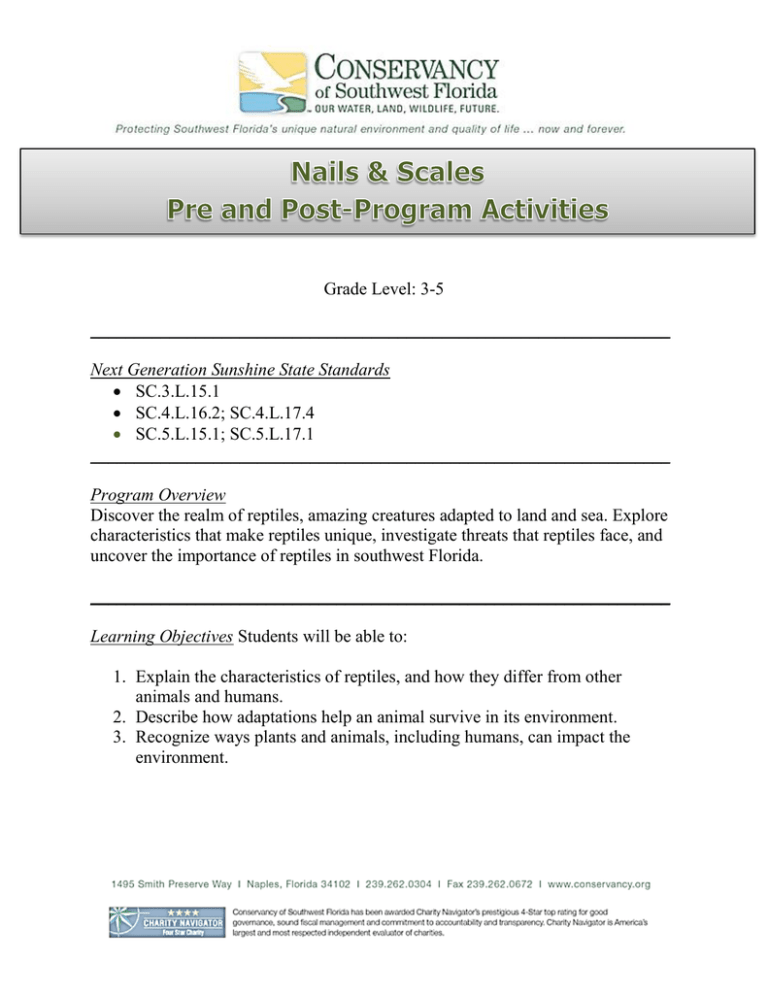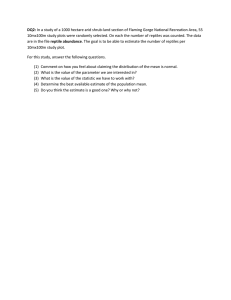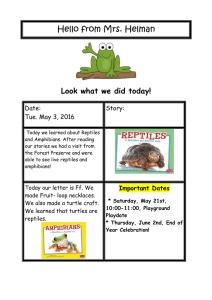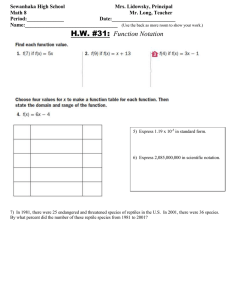Next Generation Sunshine State Standards
advertisement

Grade Level: 3-5 __________________________________________________________________ Next Generation Sunshine State Standards SC.3.L.15.1 SC.4.L.16.2; SC.4.L.17.4 SC.5.L.15.1; SC.5.L.17.1 __________________________________________________________________ Program Overview Discover the realm of reptiles, amazing creatures adapted to land and sea. Explore characteristics that make reptiles unique, investigate threats that reptiles face, and uncover the importance of reptiles in southwest Florida. __________________________________________________________________ Learning Objectives Students will be able to: 1. Explain the characteristics of reptiles, and how they differ from other animals and humans. 2. Describe how adaptations help an animal survive in its environment. 3. Recognize ways plants and animals, including humans, can impact the environment. Pre-Program Activity 1: Reptile Adaptations Duration of Activity: 1 hour Adapted from Discovery Education Reptile Adaptations Lesson http://www.discoveryeducation.com/teachers/free-lesson-plans/reptile-adaptations.cfm Materials: whiteboard, computer & projector, classroom worksheet: Reptile Research (provided), activity worksheet: Reptile Crossword (provided) Directions: 1. Stimulate prior knowledge: Share amazing facts with students: At one time, giraffes came in a variety of neck lengths. Some giraffes had much shorter necks than modern giraffes. Ask students to brainstorm why short-necked giraffes did not survive. They could not eat the leaves in tall trees and had to compete with other species that eat low laying vegetation. Give other examples such as: Dolphins have powerful tails to help them swim. Porcupines have sharp, stiff quills so they can defend themselves against predators. Or have students come up with other examples. 2. Explain that these are all ADAPTATIONS: a trait that helps it fit in and survive in its environment. 3. Ask students to brainstorm about reptiles, noting their responses on the chalkboard. Reptile traits include: dry, scaly skin breathe air through lungs have an internal skeleton with a central backbone (vertebrate) cold-blooded (body temperature changes with the temperature of the environment) lay eggs 4. Explain to the class that reptiles have been living on Earth for over 300 million years. They have been able to survive because of adaptations, both physical and behavioral, that enable them to live in their environments. Then, introduce students to the following types of living reptiles with these fun facts: Turtles spend most of their lives in the water and have a hard shell - except tortoises, which are land turtles Lizards have great vision and use their tongues to taste their surroundings. Many can lose and regenerate their tails. 5. 6. 7. 8. 9. Alligators and Crocodiles lose their teeth chomping on prey, but new sets always grow in Snakes are carnivores and can go a long time (months) without eating Divide the class into groups of two or three students. Assign each group one of the following Florida reptiles to research: snapping turtle, diamondback rattlesnake, eastern glass lizard, American alligator, sea turtle, saltwater crocodile, indigo snake, gopher tortoise, diamondback terrapin, scrub lizard, etc. You might allow them to select a different reptile of their own choice. Optional for younger students: Instead of dividing students into groups, present the class with pictures of different reptiles, such as snakes, turtles, alligators and lizards. Fill out the Retile Research worksheet together. Print out and distribute the classroom worksheet: Reptile Research to help guide students’ research. They will be creating a description of the reptile including what it looks like, where it lives, what it eats, what eats it, and its adaptations. If some groups finish early, hand out the Reptile Crossword worksheet that reviews some of the vocabulary in this lesson. When everyone is finished, discuss each reptile and various adaptations. For further discussion ask the following questions: Reptiles have both physical and behavioral adaptations that help them survive in their habitats over time. Name one physical adaptation and one behavioral adaptation from the reptiles you studied. Almost all reptiles have dry, scaly skin. Think about where most reptiles live, then brainstorm some of the reasons for their skin characteristics. Nails & Scales Nails & Scales Pre-Program Activity 2: Reptile Temperature Investigation Duration of Activity: 1 hour Adapted from Discovery Education Reptilian Adventure Lesson Plan-Session 1 http://www.esc11.net/cms/lib3/tx21000259/centricity/domain/84/degatorboysle ssonplan.pdf Materials: computer & projector, thermometer(s), Reptile Temperature Investigation worksheet, classroom space AND other site (playground, gym) for comparison Background: When a reptile brumates, it becomes lethargic, sometimes not moving at all for the duration of the cold season. In nature, these animals typically find hibernaculums within their environment in which they can be somewhat insulated. A hibernaculum is simply the place where the reptile spends these periods of inclement weather. Burrows, rock crevices, caves and leaf litter are a few examples of hibernaculums documented in nature. Some temperate species can even brumate under water! Directions: 1. Show students the following Discovery Channel segment on Reptiles (3 minutes, 5 seconds). https://www.youtube.com/watch?v=TAtGDQkZzZ8 After watching the segment, ask students to list the characteristics that all reptiles have in common (scales, lungs to breathe air, eggs with a leathery shell, backbones, cold-blooded). 2. Discuss how ectothermic (cold-blooded) animals depend on the environment to maintain their body temperature. For example, if the temperature is too cold, a reptile will find a rock on which to sun itself in order to warm up. If the temperature is too hot, the reptile might bury itself in mud to cool off. Divide students into small groups for an investigation. Distribute the Reptile Temperature Investigation worksheet. 3. Complete the Reptile Temperature Investigation. As students predict the warmest and coolest areas in their environment, remind them to give reasons behind their predictions. For instance, “We think the warmest place is by the window because the sun is always shining there.” After students have determined the locations they want to test, they should determine and write down the current temperature prior to leaving the thermometer in that location. Wait at least 5-10 minutes before checking to see the results. 4. After 5-10 minutes, students should take the second temperature reading and complete the data chart. 5. If time allows (or on a different day), repeat investigation at a different site. 6. Gather together briefly as a class for students to share their results. Determine from the class results which were the warmest and the coolest locations in each area tested. Be sure to discuss the concept of brumation and how reptiles become less active during cold weather months. Mention how brumation is similar to hibernation. Provide time for students to complete the results and conclusion parts of the investigation student page. (Worksheet provided on next page) Post-Program Activity 1: Schoolyard Species Inventory Duration of Activity: 1 hour Materials: pencils, paper and clipboards (enough for every student or team) Directions: 1. Browse the FWC Species Profile Website together as a class: http://myfwc.com/wildlifehabitats/profiles/reptiles-and-amphibians/ 2. Pick an open place outside near your school where students can move around (ideally a place with a few trees and some shade). Bring pencils, paper and clipboards. 3. Have students work individually or in teams. Have them create a ‘Species Inventory’ chart on their papers. Example: Species (animal) Abundance (tally marks) Lizards Snakes Turtles Other 4. Allow students time to explore their area, searching for reptiles, making a tally mark for each one they find. Modification(s): You may choose to scout out the area before the activity to search for critters. If locating reptiles proves to be difficult, you may choose to include ALL animals on student charts, i.e. Birds, Mammals, Reptiles, Amphibians, Fish, Insects. This way, if no reptiles are spotted, you may use it as a teaching point to talk about why (insufficient habitat, warmth, food/water, etc.). 5. Once you are back in the classroom discuss with students their findings. Discuss “why” or “why not” certain animals were found. 6. Extended learning: Create a class bar graph of each student/teams’ species abundance. Post-Program Activity 2: Research a Reptile Duration of Activity: 1-1.5 hours Materials: computer lab Directions: 1. Have each student select a Florida reptile of choice. Some ideas are: Lizards: green anole, eastern glass lizard (a legless lizard!), scrub lizard Alligators: American alligator, saltwater crocodile, Caiman Snakes: eastern indigo snake, Florida pine snake, king snake, red rat/corn snake, yellow rat snake, banded water snake, black racer, eastern diamondback rattlesnake, pygmy rattlesnake, cottonmouth/water moccasin, coral snake Turtles: gopher tortoise, box turtle, peninsula cooter, yellow-bellied slider, red-eared slider, mud turtle, chicken turtle, diamondback terrapin, green sea turtle, loggerhead sea turtle, leatherback sea turtle, hawksbill sea turtle, Kemp’s Ridley sea turtle 2. Go to the library or computer lab and have students research their chosen animal, focusing on the following questions (or any others that you choose): What are its characteristics? What type of habitat does it live in? What does it eat? Is it venomous? Any other ‘fun facts’? 3. Have students create a ½ - 1 page report about their chosen animal and share with the rest of the class.



